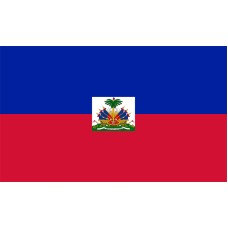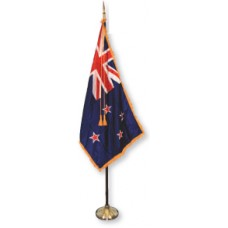Haiti Flag
We carry authentic Haiti Flags in both indoor and outdoor varieties. Our flags are proudly made in the United States from durable nylon and are printed with vibrant long-lasting inks. The Haiti national flag is often displayed at embassies, outside of businesses associated with Haiti, and at the homes of people who take great pride in their Haiti heritage.
Our indoor flags are finished with a pole hem and your choice of with or without golden fringe. Gold fringe is the traditional way to display an indoor flag, however, some people choose without fringe for a simple and clean look that is also less expensive. If you are looking for a complete indoor presentation set, our Build Your Own Indoor International Flag Set program allows you to select a durable nylon indoor Haiti Flag and choose between premium quality poles, bases, and ornaments, and tassel. For indoor applications, most buyers choose a 3ft. x 5ft. flag with an 8ft. pole, however, if you have a low ceiling, you may opt for a 7ft. pole, which is designed to work with drop ceilings. If you are looking for a very substantial international flag display, our 4ft. x 6ft. indoor flags can be paired with a 9ft. pole for our largest indoor display option.
Our outdoor international flags are finished with a canvas header and brass grommets and are offered in four sizes: 2ft. x 3ft., 3ft. x 5ft., 4ft. x 6ft., and 5ft. x 8ft., to fit any sized flagpole. Typically, outdoor flags are flown outside of government organizations, businesses, and institutions on in-ground and wall-mount flagpoles, however, some people also buy these flags to display their international pride at home. If you are looking for a wall-mount Haiti flag set to display outside of your home, our Build Your Own Outdoor International Flag Set program will allow you to choose between premium quality 6ft. poles and brackets to display the Haiti Flag on your front porch. Outdoor flags can also be displayed indoors on interior walls of your home with screws anchored in the wall to attach to the grommets.
In addition to the flags we offer for purchase, we maintain an archive of the audio and lyrics of the Haiti National Anthem, historical information about the Haiti flag, demographic data about Haiti, and free high resolution images of the Haiti flag for use in projects and on websites.
Regardless of your application, we are looking forward to working with you to provide the required flags, flagpoles, and hardware for your application. If you need assistance, please reach out to us by phone, email, or chat, and we will be happy to help.
History of the Haitian Flag
The flag of Haiti is comprised of two bands of color: blue and red. The design is modeled after the tricolor of France who used to occupy this island nation. These bands sit horizontally and in a white box centered across them in the middle of the flag is the country's coat or arms. This coat of arms consists of a green hill upon which sits a parade of weapons that signifies the defense of freedom, and a Royal palm signifying independence. On the top of the palm sits a cap of liberty and at the base of the green hill there is a white banner upon which the words "L'Union Fait La Force" sit, which translates as "Unity Makes Strength."
Haiti is located in the Caribbean Sea on a large island called Hispaniola but it only occupies about 3/8 of the land at the western end as the rest of the island is the country of The Dominican Republic.
This island has a very interesting history starting with the fact that it was first discovered by Christopher Columbus in 1492 and initially he thought he had found China or India. When Columbus's flagship ran aground on the island on Christmas Day in 1492 and his crew had to rescue what they could and take refuge on the island, he named it La Navidad after the date of Christmas Day.
It became the first part of the Americas that was settled by Europeans and once Spain claimed it as theirs they named it La Espanola. The Spanish kept control of it until the early seventeenth century when they then ceded the part that is now known as Haiti to France who named it Saint-Domingue.
Under French rule, the island became rich in sugar cane plantations using slaves from Africa as the workforce. These slaves were instrumental in gaining independence of the island from France. They and the "people of free color" took advantage of the disruption caused by the revolution in France to stage their own revolution in Haiti. Through this they achieved the abolition of slavery on the island and the island become an independent sovereign state on January 1st, 1804. This is the only time that a slave revolt had led to the creation of an independent country where all the first leaders of the government of the country were former slaves.
There are stories of how the flag came to be and it has gone through a number of changes until it became the flag that is in use today. Haitian myth tells how the first flag of the Haitian Republic came into being when the appointed revolutionary leade - Jean-Jacques Dessalines took the French Tricolor and tore out the white center band. He then instructed his God daughter, Catherine Flon to sew the two remaining bands together. The blue part would now represent the slaves and the red part now represent the people of free color who together brought about the country's independence. Based on this story and how the nation came to be, it is perhaps why the flag of Haiti is so important to its people and celebrated with them holding a flag day on May 18th every year.
Geographic Coordinates
Area
Population
Life Expectancy
Government Type
Capital
GDP
Currency
Calling Code
Internet TLD
Haiti National Anthem
The Dessalines Song (La Dessalinienne)
Listen
Lyrics
For our country,
For our forefathers,
United let us march.
Let there be no traitors in our ranks!
Let us be masters of our soil.
United let us march
For our country,
For our forefathers.
For our forebears,
For our country
Let us toil joyfully.
May the fields be fertile
And our souls take courage.
Let us toil joyfully
For our forebears,
For our country.
For our country
And for our forefathers,
Let us train our sons.
Free, strong, and prosperous,
We shall always be as brothers.
Let us train our sons
For our country
And for our forefathers.
For our forebears,
For our country,
Oh God of the valiant!
Take our rights and our life
Under your infinite protection,
Oh God of the valiant!
For our forebears,
For our country.
For the flag,
For our country
To die is a fine thing!
Our past cries out to us:
Have a strong soul!
To die is a fine thing,
For the flag,
For our country.
Download Haiti Flag Images
We offer free images of the Haiti Flag in four sizes (small, medium, large, and high resolution). These images are distributed royalty free for both personal and educational use and are ideal for use in projects and on websites. If you choose to use one of our images, attribution is appreciated, but not required.
- Small Icon (PNG, 30x18px)
- Medium Image (PNG, 125x75px)
- Large Image (PNG, 525x315px)
- High Resolution Image (PNG, 3000x1800px)
Add the Haiti Flag to your Website:
The following html code snippets can be copied and pasted to add an image of the Haiti Flag to your website:
Small Flag Icon






